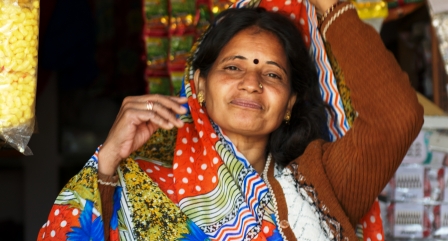Sana Amir for BeyondHeadlines
Shishvi is a small village located in Girwa block of Udaipur City, Rajasthan. A five minutes’ walk into the village and you will meet a confident woman running a small shop. Nirmala Lohar is the first female in the village to run a shop.
As expected the journey was not easy. Before breaking the societal barriers, she had her family to fight to.
“My husband is into maintenance work. We never had enough money and that created trouble and eventually fights.” Nirmala has three kids- two girls and one boy. Her family was not very supportive.
But Nirmala was determined. She started this shop in 2006. It has been 7 years and she has been increasing her business day by day. She had no education and no money when she thought of opening this shop. She just knew stitching clothes but did not have a sewing machine.
Seva Mandir, a local NGO in Udaipur, runs a women’s Self-Help Group in Shishvi where women voluntarily contribute whatever amount they can and mutually agree to save it in their common fund from which small loans can be given to any of their members to meet emergent credit needs. This is exactly what Nirmala was looking for. She happily joined the group, discussed her problem and took a loan of Rs. 10,000. She bought a sewing machine and some cloth from it.
Nirmala then started selling ready-made clothes in Shishvi. This grabbed local women’s attention since this was the only shop with ready-made clothes. Initially she used to sell covertly because the ‘heads’ of the village were against it! But Nirmala stood strong and so did other women.
“All the women here supported and encouraged me. They kept coming to my shop and asked me to be strong as I was doing a good work.”
She returned the first loan in around two years. She then took the second loan of Rs 20,000 from Union bank. She bought saris, more clothes and got more profit. She returned the second loan in 20 months.
After this 18 women took loan together of Rs 25,000 from ZilaUdyog Kendra. In between Nirmala kept taking financial help from self-help group.
Currently there are three shops in Shishvi run by women.
Nirmala earns Rs1000 per day from which she keeps Rs500 and uses Rs500 in buying clothes or other commodities for shop. She makes more than Rs1000 in festive season. “I earned Rs4000 in Rakhi festival” says Nirmala.
When she started earning respectable money, Nirmala’s family also began to accept her running the shop. They became friendly and encouraged her. “My husband supports me in my work now. In fact he attached some equipment to my sewing machine so that it can run on electricity. Earlier I used to run it manually,” says Nirmala showing her possession-sewing machine.
Nirmala adds confidently that there house was a mud house before. She helped her husband financially in turning it into a cement house. She also participates in decision-making as well.
She is working with the NGO, Seva Mandir, on one of the projects where she will teach local girls stitching and using sewing machine.
SELF-HELP GROUPS
Self-help groups started from Bangladesh under the supervision by Nobel laureate Mohamed Yunus and from there the idea spread to various parts of the world.
Self-help groups are a village based homogenous group created by local people ranging from 10-20. This group is voluntarily formed and members save a part of their earnings in a common fund. This fund can be used by the members for credit needs. Rate of interest and terms of loans are decided by the group itself. These groups are mostly unregistered.
Government identifies and registers these groups. It then brings these groups in contact with banks. These self-help groups are monitored under National Bank for Agriculture and Rural Development (NABARD) scheme by government.
NABARD functions are ‘involving preparation of potential-linked credit plans annually for all districts of the country for identification of credit potential, monitoring the flow of ground level rural credit, issuing policy and operational guidelines to rural financing institutions and providing credit facilities to eligible institutions under various programs.’
According to Status of Microfinance in India 2006-07 to 2010-11, the number of SHGs was 47.26 lakh in 2010-11.
Other government schemes working for self-help groups are Swarnajayanti Gram SwarojgarYojna (SGSY) and National Rural Livelihoods Mission (NRLM).
In accordance with the announcement made by Finance Minister P. Chidambaram in the 2012-13 Budget, the Union Cabinet on May 1, 2013 also approved interest grant for Women SHGs operating under NRLM, ensuring that they can take loans up to Rs. three lakh at an interest rate of seven per cent per annum.






















